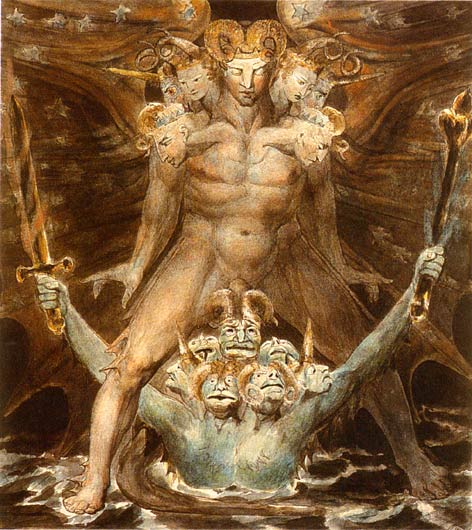- New Revelation Series
- Revelation Study Foreword
- Revelation Chapter One
- Revelation Chapter Two
- Revelation Chapter Three
- Revelation Chapter Four
- Revelation Chapter Five
- Revelation Chapter Six
- Revelation Chapter Seven
- Revelation Chapter Eight Part I
- Revelation Chapter Eight Part II
- Revelation Chapter Nine Part II
- Revelation Chapter Nine Part I
- Revelation Chapter Ten
- Revelation Chapter Eleven Part I
- Revelation Chapter Eleven Part II
- Revelation Chapter Eleven Part III
- Revelation Chapter Twelve Part I
- Revelation Chapter Twelve Part II
- Revelation Chapter Twelve Part III
- Revelation Chapter Thirteen Part I
- Revelation Chapter Thirteen Part II
- Revelation Chapter Thirteen Part III
- Revelation Chapter Fourteen Part I
- Revelation Chapter Fourteen Part II
- Revelation Chapter Fourteen Part III
- Revelation Chapter Fifteen
- Revelation Chapter Sixteen Part I
- Revelation Chapter Sixteen Part II
- Revelation Chapter Seventeen Part I
- Revelation Chapter Seventeen Part II
- Revelation Chapter Eighteen
- Revelation Chapter Nineteen Part I
- Revelation Chapter Nineteen Part II
- Revelation Chapter Nineteen Part III
The theme of Revelation Chapter 13 is the arise of the Antichrist and the False Prophet. In the opening scene we observe the dragon, or Satan, is presiding over the rise of the beast out of the sea.
Revelation 13:1 “And I stood upon the sand of the sea, and saw a beast rise up out of the sea, having seven heads and ten horns, and upon his horns ten crowns, and upon his heads the name of blasphemy.
[More accurate: And he (the dragon) stood upon the sand of the sea and I (John) saw a beast rise up out of the sea…]
In some translations, both modern (e.g. NIV), and ancient (e.g. Wycliffe), the first part of this verse is the last verse in Revelation Chapter 12. In Chapter 12 it is verse 18. Here is an example of the entire paragraph, staring with Rev 12:17 and ending with Rev 13:1:
Rev 12:17-18 And the dragon was angry at the woman, and went away to [fight against] the rest of her children, those who keep the commandments of God and who hold to the testimony about Jesus. 18 And he stood on the sand of the sea. 13:1 And I saw coming up out of the sea a beast that had ten horns and seven heads, and on its horns ten royal headbands, and on its heads a blasphemous name. (Lexham English Bible).
There is another difficulty with the verse. The phrase, “I stood upon the sand of the sea” can literally and properly be translated I, it, or he “stood upon the sand of the sea.” Earlier Greek manuscripts generally use the verb inflection, εσταθη, estathē, meaning “he, it, or an object stood,” which is an indicative aorist passive 3rd person singular verb. Later manuscripts generally use εσταθην, estathēn, “I stood,” which is an indicative aorist passive 1st person singular verb. The difference between the two is one letter, nu, “ν.”
In English, the difference is “someone or something stood upon the sand of the sea,” which is third person vs “I stood upon the sand of the sea,” which is first person. The oldest manuscripts, which are closer to the originals, largely use the third person, while later manuscripts tend to use the first person. There are exceptions to each.
Hence, some translations say, “I stood upon the sand of the sea.” Others say, “He stood upon the sand of the sea.” Yet others say, “The dragon stood upon the sand of the sea.” The dragon is identified as Satan in Rev 12:7, and Rev 20:2. Some say that use of the first person (“I stood”) was a scribal error. Others say it is a corruption. It is likely that this was simply a translator’s decision. It matters not, for the only way to really understand which is correct is to take the full context of the passage into consideration.
Revelation 12:17 through Rev 13:1, is a complete paragraph (above). Separating it into two different chapters alters the context as well as the original meaning. The context of the entire book of Revelation shows John in heaven observing these things, “in the spirit.” Rev 4:2, “And immediately I was in the spirit: and, behold, a throne was set in heaven, and one sat on the throne.” See also Rev 17:3 and Rev 21:10. Both tell us that John was in the Spirit, and not standing on the earth and both use the same words: “he carried me away in the spirit.“
The context of the paragraph tells us that the dragon (Satan) was angry with the woman that gave birth to the Christ Child. Accordingly, the dragon went after Christ’s spiritual offspring, which are Christians, to persecute them. In order to do so, the dragon oversaw the beast rising from the sea of nations. The dragon has complete control of the beast (Rev 13:2). He uses both beasts in chapter thirteen to persecute Christians. This is the correct contextual meaning of the entire phrase. Robertson puts it this way, “‘He stopped’ on his way to war with the rest of the woman’s seed.1 ” Which is exactly what Antiochus Epiphanes did when he attacked Israel (Dan 11:28).
The word “seas” is used symbolically of the nations. Revelation 17:15 plainly explains this: “And he saith unto me, The waters which thou sawest, where the whore sitteth, are peoples, and multitudes, and nations, and tongues. In Daniel, the sea refers to the nations and peoples upon which the four winds of heaven blew when the four empires arose from it. The Hebrew term for nations is גּוי, goy, or gentiles. Dan 7:2-3, “Daniel spake and said, I saw in my vision by night, and, behold, the four winds of the heaven strove upon the great sea. And four great beasts came up from the sea, diverse one from another. Those beasts were the four world empires in Daniel.
Isaiah 17:12 states, “Woe to the multitude of many people, which make a noise like the noise of the seas; and to the rushing of nations, that make a rushing like the rushing of mighty waters!” See also Psalm 24:2, Psalm 46:2-3, Psalm 65: 2&3, Psalm 68:22, Isaiah 5:30, Isaiah 11:11, Isaiah 60:5, Jeremiah 6:23, Jeremiah 47:2, Jeremiah 51:42, and many, many others.
What are the sands of the sea? Literally they are the innumerable grains of sand under the sea and on any beach in the world. However, they are used figuratively in the Bible. Genesis 22:17 states what God promised Abraham about his progeny, “That in blessing I will bless thee, and in multiplying I will multiply thy seed as the stars of the heaven, and as the sand which is upon the sea shore; and thy seed shall possess the gate of his enemies.” Here this is limited to the sands on the seashore, which are still innumerable.
The offspring of Abraham, the father of many nations, will be innumerable just like the sand of the sea. These sands are used figuratively to represent the people of the many nations that will come from Abraham. That does not just include Israel, but all of Keturah’s, Hagar’s and Sarah’s progeny. In other words, they are represented in all the nations and peoples of the world. The bible also tells that the children of Jacob (Israel) would be as the numerous as the sands of the sea in Genesis 32:12. This includes the posterity of his thirteen sons and all future generations.
The Dragon, which is Satan (Rev 12:9, 20:2), is always “going to and fro in the earth, and from walking up and down in it” (Job 1:7, 2:2). He walks about on the earth like a roaring lion (1 Pet 5:8). We see that Satan roams about the world, which is sometimes symbolized by the sea. This shows us that Satan, the dragon, has control over the entire earth, and the peoples thereof except for God’s elect, that is, saved Jews and Saved Gentiles, which the Apostle Paul identifies as the Israel of God (Gal 6:16).
We also understand the Satan already has the world and its people under his control; they belong to him. That explains why “the dragon was wroth with the woman, and went to make war with the remnant of her seed, which keep the commandments of God, and have the testimony of Jesus Christ” (Rev 12:17). Since he owns the world and its people, he has no reason to go out after them, but has every reason, in his mind, to persecute God’s people, who are Christians.
He is doing so now, and it will become quantitatively worse as the world gets closer to its end. Christians will and do undergo tribulation. All of us have undergone some tribulation in our lives, some much worse than others, and many will do so in the future.
The dragon standing on the seashore is a word picture of Satan lording it over the peoples of the world. The sea from which the beast rises is a word picture of the beast coming out of the nations and kingdoms of the world; but specifically out of the three kingdoms Daniel saw in his dream in Dan 7:1-6.
John saw a beast rise up out of the sea.
The word translated beast is θηριον therion (Strong’s 2342), which means a wild, dangerous, venomous animal. In Revelation 4, the word beast (ζωον, zoon) was a translation of a word meaning living creature. In fact, most Bible versions render the word as “living creatures.”
The beast here in this verse is a dangerous, wild, and venomous monster. The living creatures of Revelation chapter four are definitely not the same as this beast. They are servants of God; they are cherubim. In Daniel chapter 7 we see four beasts arising from the sea, which represent the nations. Daniel shows us that this beast represents a kingdom, an empire, or a political system and its leader, which we will see from the context as we delve further in the Scriptures. This is the fourth and final beast in Daniel’s dream. It is “dreadful and terrible, and strong exceedingly” (Dan7:7).
As we can see, John’s beast has seven heads. We also saw a dragon, which is Satan, with seven heads and ten horns in Revelation 12:3: “And there appeared another wonder in heaven; and behold a great red dragon, having seven heads and ten horns, and seven crowns upon his heads.” This beast is a red dragon. He is Satan. In Rev 12:3, the dragon has ten horns and seven heads with seven crowns, but here, in 13:1, the beast has ten horns with ten crowns on the ten horns but no crowns on the heads.
The beast here in our verse is same as that beast we see from a different vantage in Revelation 17. There are two slightly different descriptions of the beast in Revelation. In appearance they appear almost identical to the dragon, “behold a great red dragon, having seven heads and ten horns, and seven crowns upon his heads” (Rev 12:3).
Rev 13:1, and saw a beast rise up out of the sea, having seven heads and ten horns, and upon his horns ten crowns, and upon his heads the name of blasphemy.
Rev 17:3), and I saw a woman sit upon a scarlet coloured beast, full of names of blasphemy, having seven heads and ten horns.
There is a good reason for the resemblance, for we see in next verse that the Dragon gave the beast his power, his seat, and great authority. The beast will represent the Dragon, Satan, on earth. The beast will do as the Dragon says and will accomplish the Dragon’s every purpose. The beast will have the power and authority to do exactly what Satan, the Dragon, wants. It will carry out all the Dragon’s desire. The beast is a kingdom with a king.
The seven heads are discussed in Revelation 17. For our purposes in this verse we will simply state that the seven heads are seven kings and kingdoms, though the seventeenth chapter goes into greater detail. We will learn more when we get to that chapter. There the angel gives us the details of the kings and kingdoms. We must learn other things before we understand that picture of the beast. However, we will look at a portion of what is written in chapter 17, to enhance our understating of this chapter.
Rev 17:9-10, And here is the mind which hath wisdom. The seven heads are seven mountains, on which the woman sitteth. (10) And there are seven kings: five are fallen, and one is, and the other is not yet come; and when he cometh, he must continue a short space.
The angel tells us that the seven heads are also seven mountains. Mountains sometimes used in the scriptures often as symbols for kingdoms or empires. (See Psa 2:6; 48:1; Isa 66:20; Jer 51:25; and Joel 3:17). The angel also identifies the heads and mountains as kings, further proving that these mountains are kingdoms. These seven heads, or mountains are seven kingdoms that have ruled on the earth, and the seventh is the last.
Rev 13:2 And the beast which I saw was like unto a leopard, and his feet were as the feet of a bear, and his mouth as the mouth of a lion: and the dragon gave him his power, and his seat, and great authority.
This beast, or kingdom, or empire is the fourth kingdom in Daniel’s dream in Daniel chapter seven. It is a combination of Daniel’s first three beasts, and is the kingdom of the Antichrist. We will look further into this in our discussion of verse 3.
We first learned of these beasts in Daniel chapter seven. There are four separate beasts in Daniel and three in this verse. Daniel’s fourth beast was “dreadful and terrible, and strong exceedingly; and it had great iron teeth: it devoured and brake in pieces, and stamped the residue with the feet of it: and it was diverse from all the beasts that were before it; and it had ten horns.” Again, we will consider the details of Daniel’s fourth beast shortly. For now, however, let us concentrate on the first three, which make up the fourth—those listed in this verse. The similarities between the three in Daniel and these three in Revelation are great. Let us list them.

In both Daniel and Revelation the beasts rise out of the sea, that is they arise from the nations of the world. There is no doubt that in Daniel the beasts are kingdoms that arose out of the nations throughout history. Because they are kingdoms in Daniel, we can safely understand that the beast in Revelation 13:1 is a kingdom or at least a political entity. Daniel’s list is in historical order and the list in Revelation is in order from the most recent back to the earliest. The lists are arranged from the perspective of the observers—Daniel and John. From Daniel’s perspective, they were all future and from John’s they were in the past.
There have been several differing opinions among scholars as to who these kingdoms in Daniel were. But the general consensus is that the lion is Babylon, the bear is Medo-Persia2, the leopard is Alexander’s (and his four Generals’) Greece. These correspond with the image of Nebuchadnezzar’s dream. The head of gold represents Babylon, the chest of silver represents Medo-Persia, the belly and thighs of bronze represent Greece under Alexander.
In Daniel there are three beasts, but we only have one here in Revelation. It is a composite of Daniel’s three beasts. Daniel’s beasts were a lion, bear, and leopard. John’s beast was made up of a leopard, bear, and lion. It was given power by the dragon, which is Satan (Rev 12:9 & 20:2).
Daniel’s beasts were four distinct kingdoms with their kings. Their power came from God and we know that because of verses like Daniel 2:37 “Thou, O king, art a king of kings: for the God of heaven hath given thee a kingdom, power, and strength, and glory.” Daniel was speaking to Nebuchadnezzar king of Babylon. God also raised up kings like Cyrus in Isaiah 44:28 and 45:1 and Darius in Daniel 5:23-31. All leaders of kingdoms, empires, and states, territories, etc., whether evil or righteous, rule at God’s pleasure; see also Dan 2:21; Isa 41:25; Jer 50:41; 51:11.
Scripture tells us that the two wild, dangerous, venomous beasts in Revelation Chapter 13 receive their power from Satan (Rev 13:2). However, though Satan has power on this earth temporarily, God is the ultimate power over all, but allows Satan dominion over earth (Job1:6-7, 2:1-2; 1 Kin 22:19-23; 2 Cor 4:4; John 12:31; Eph 2:2). This beast is a kingdom, empire, or even a caliphate and its leader; it is a political system of some sort. The beast is under Satan’s power as long as Yahweh allows.
The explanation of Daniel’s beasts begins in Daniel 7:17: “These great beasts, which are four, are four kings, which shall arise out of the earth.” The beasts are four kings, which are human men, and they are kingdoms as well. Daniel tells us the beasts are also kingdoms (Dan 2:37, 39, 40). Yes, they are kingdoms led by kings. Consequently, the beasts are kingdoms led by men who are kings. It stands to reason that John’s beast is a kingdom that has a king who is a man. We may also refer to kingdoms as states, empires, caliphates, political systems, federations, countries, territories, etc., all of which have a leader.
The three beasts from Daniel were three kingdoms, Babylon, Medo-Persia and Greece. The final kingdom in the world (Daniel’s fourth kingdom) will be a single kingdom that is a combination of all three of these kingdoms. Let us view a few maps that will gives us a better idea of the area we are seeing here in Revelation chapter thirteen.
The end times empire of the Beast is a conglomerate of all three of the kingdoms described above and in Daniel. Take a look at the following maps and you will see that the only empire that occupies the same territories as the three kingdoms from Daniel occupied is the Islamic Empire, which was conquered by the Ottoman Empire.
The ottoman empire ceased to exist in 1924. Its territory was then broken into several states including the modern territories of Turkey, Greece, the Balkan states, Iraq, Iran, Yemen, Syria, Jordan, Lebanon, Israel, Arabia, Egypt, and several others.
The following maps show the geographic areas of all three kingdoms.
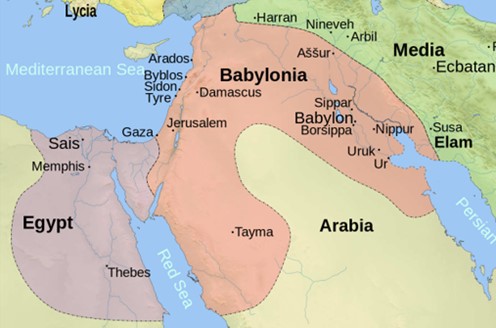
Babylonian Empire – The Lion
Licensed under CC BY-SA 3.0
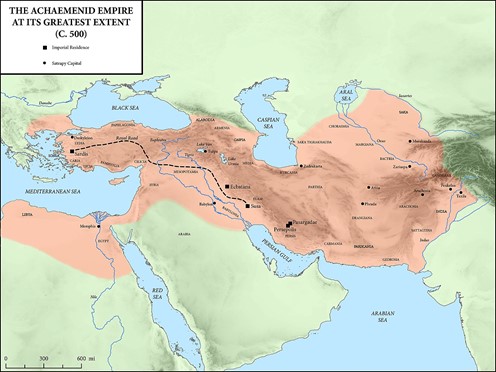
Medo-Persian – the Bear (Achaemenid or Persian) Empire
Licensed under CC BY-SA 4.0
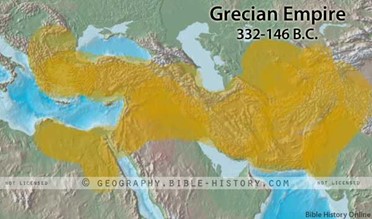
Grecian Empire under Alexander the Great – The Leopard.
©Geography, Bible-History.com (Not licensed, freely distributed)
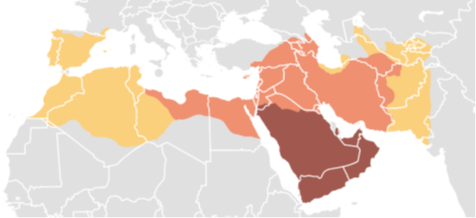
Islamic Caliphate in the Age of the Caliphs
(Eventually conquered by the Ottoman Empire, below)
CC0 Public Domain
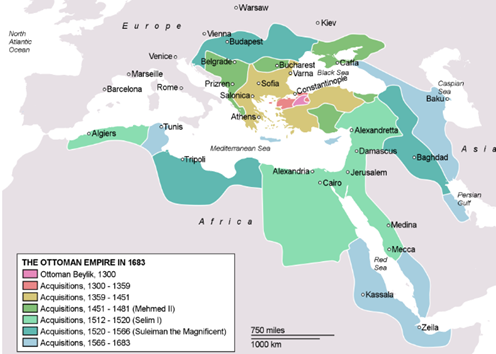
Ottoman Empire 1683 AD
CC0 Public Domain
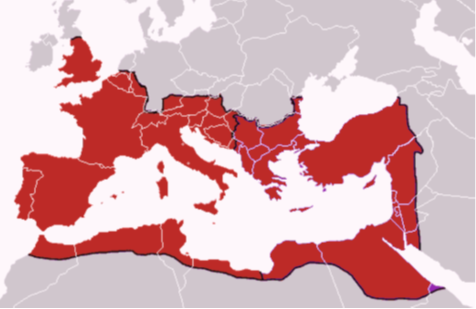
Roman Empire c. 400 AD,
Geuiwogbil, Licensed by CC-SA3.0
If one takes combined geographical area of the Babylonian, Medo-Persian, and Grecian areas and superimposes that area as one combined area directly on top of the area that encompassed the Islamic Caliphate, one will find that the resulting image fits very nicely in the Islamic Caliphate, which became the Ottoman Empire. If superimposed over the Roman Empire it does match like it does with the Islamic Caliphate. This is the Beast that comes out of the sea. It is the combined kingdoms of Daniel’s vision.
There are many that adhere to the doctrine of the Revived Roman Empire, which will be the Beast of Revelation 13, and the kingdom of the Antichrist. Yet when one reads the Scriptures critically and allows the Scriptures to interpret the Scriptures, and puts away all preconceived notions, one must see that the idea of the end-times empire being Rome Revived is simply not plausible. Daniel’s lion, bear, and leopard simply do not fit in the area occupied by the Roman Empire.
There is a map of the area of the Roman empire included to show that the Beast cannot be the so-called “Revived Roman Empire.” The geographic area of the empire is completely different than that of the geographic area of the three kingdoms.
Yes, the Roman Emperor Trajan attempted to move the Roman border eastward into Parthia, a territory that today lies in eastern Iran. At that time, the eastern border of the Roman Empire was 500 miles west of Babylon. Trajan’s invasion of Parthia began in Mesopotamia. Perhaps he attempted to gain control over eastern trade routes or to increase Rome’s tax base. However, historians are undecided about the reason for invading Parthia.
Trajan made it all the way to Babylon and captured the city. Having secured Babylon, Trajan went north and at the siege of the city of the city of Hatra, which is now in ruins in modern Iraq, Trajan’s health declined when there he suffered a heat stroke. While he was occupied there, the Jews in the Empire revolted. That forced Trajan to withdraw his troops from Mesopotamia (which includes Babylon) due to stretched Roman military resources. His health continued to decline, and he died on August 8, 117 AD.
Hadrian succeeded him and upon his succession, Hadrian abandoned Mesopotamia by reinstating the Augustan policy of consilium coercendi intra terminos imperii, roughly “the policy to keep the border within the empire.” Other than the few months that Trajan adventured in Parthia, Western Rome’s eastern border remained west of the Euphrates until the demise of Rome in AD 476.
The Ottoman empire arose in the area of the Islamic Caliphates of Rashidun, Umayyad, and Abbasid. The Abbasid Caliphate fell in 1258 AD, while the Ottoman Empire began in 1299 AD and occupied roughly the same territory of the Caliphates.
Many modern commentators maintain that the end times empire of the Antichrist will be the revived Roman Empire. Yet when we superimpose the old Islamic Empire over the areas of Daniel’s three combined kingdoms, we immediately see that the fit is almost identical.
The Roman Empire was split into eastern (European) and western (Byzantine) divisions. The Western Roman Empire ended 476 AD when the Barbarian Odoacer deposed the last emperor. The Eastern Roman Empire ended in 1453 AD when the Ottoman Empire conquered Constantinople and renamed it Istanbul. If we are to take what the Scripture says seriously, we will discover that the idea of a revived Roman Empire is unsound. However, the territory of a future revived Ottoman or Islamic Empire, fits the scriptures well.
Again, if we are to fully accept what the Bible tells us, we have no recourse but to admit that the idea of a revived Roman Empire is simply not in accord with Scripture.
Copyright 2021, The Bible Church Online
Do you know Jesus Christ as your Savior? He is going to return to the world soon. Are you ready? When He does if you do not know Him as your Savior, you will join all those who do not know Him in “Outer Darkness where there will be weeping and gnashing of teeth.” (Mat 22:13-14).
Mark Oaks, January 28, 2021

